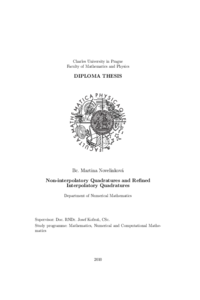Neinterpolační a zjemněné interpolační kvadratury
Neinterpolační a zjemněné interpolační kvadratury
diplomová práce (OBHÁJENO)

Zobrazit/
Trvalý odkaz
http://hdl.handle.net/20.500.11956/34462Identifikátory
SIS: 77457
Katalog UK: 990013938660106986
Kolekce
- Kvalifikační práce [11978]
Autor
Vedoucí práce
Konzultant práce
Najzar, Karel
Oponent práce
Strakoš, Zdeněk
Fakulta / součást
Matematicko-fyzikální fakulta
Obor
Numerická a výpočtová matematika
Katedra / ústav / klinika
Katedra numerické matematiky
Datum obhajoby
7. 9. 2010
Nakladatel
Univerzita Karlova, Matematicko-fyzikální fakultaJazyk
Angličtina
Známka
Výborně
Tato práce se převážně zabývá tématem zjemněných interpolačních a neiterpolačních kvadraturních vzorců. Začátek je věnovaný obecnému úvodu do problematiky numerické integrace a jsou zde uvedeny základní poznatky o interpolačních kvadraturních vzorcích. Dále v práci zkoumáme vlastnosti ortogonálních polynomů, které jsou důležitým nástrojem při budování zjemněných interpolačních kdvadratur. Nosná část textu je věnována podrobnému popisu některých speciálních tříd zjemněných interpolačních kvadraturních vzorců, jako například obecné a klasické Gaussově kdvadratuře a jejím modifikacím. Lze zde také najít shrnutí nejdůležitějších vlastností Rombergovy kvadraturní schémy a je načtrtnuta konstrukce odhadů chyby pro tento vzorec. Práce obsahuje taktéž numerické experimenty, tedy praktické ověření uvedených vlastností pro Clenshaw-Curtisovu schému, Rombergovu kvadraturu a jejich porovnání se složeným lichoběžníkovým pravidlem.
Most of this work deals with refined interpolatory quadrature formulae. The first part is focused on the general background of the problem of numerical integration and some of the basic properties of interpolatory quadratures are discussed. Further in the work, the systems of orthogonal polynomials are introduced and their most important characteristics are proved. A part of this text is dedicated to detailed description of some refined interpolatory quadratures, such as general and classical Gauss quadrature and their modifications. We summarise also the most imporant properties of Romberg's quadrature formula and show the error estimations. This work also includes numerical experiments which practically show the introduced statememnts and comparison of errors of Romberg formula, Clenshaw-Curtis scheme and trapezoidal rule.
